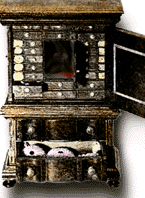
CABINETS OF CURIOSITY: SITES OF KNOWLEDGE
Cabinets of Curiosity were gathered by princes, popes, merchants, scholars and even tavern-keepers. Their contents varied according to the means and interests of their owners: physicians collected anatomical specimens; merchants bought rarities from far-flung trading posts; artists gathered prints, drawings and casts of ancient sculpture; princes and potentates inventoried local resources. These sixteenth-century collections had a variety of names. Kunst-kammern were devoted to art and splendid examples of human artifice. Schat-kammern were where rulers hoarded crown jewels and other precious objects. Ruest-kammern housed armor and weaponry. But most inclusive was the Wunder-kammer, the Studiolo, the Rariteitenkabinett--Curiosity Cabinets, which were as thorough representations of the world as lay within the means of the collector.
 |
Curiosity Cabinets, containing hundreds or even thousands of specimens, proved ideal sites for the comparative analysis of specimens that forms the basis of most modern humanities and sciences, such as biology, chemistry, geology, anthropology, and history. The Curiosity Cabinet is the precursor of the museum and, like the museum, performed an educational function, facilitating the accumulation and dissemination of knowledge and encouraging both theoretical and practical applications. Unlike the modern museum, however, the Curiosity Cabinet was not intended for a public audience; knowledge was power, and thus was the private preserve of an elite few.
Knowledge in a Curiosity Cabinet was not segregated into separate disciplines as it is in modern scholarship. The pursuit of knowledge was a synthesizing activity, based more on qualitative comparison than on quantitative analysis. Aesthetics and science, mathematics and mysticism, ethics and natural history were all interconnected, intertwined into an all-encompassing system of visual correspondence and poetic resonance. Any number of associations between objects could be made in a Curiosity Cabinet, and the objects thus participated in a variety of categories simultaneously.
The abundance of objects in the Curiosity Cabinet imposed the need to classify, which in
turn required constant reassessment of the very nature of the material being studied.
Here, for the first time, scholars began to piece together the patterns of individuality
and familial resemblance which are the fundamental starting points for disciplines as
geology and anthropology, art history and chemistry, botany and comparative literature,
and many more. Then, as now, curiosity about the world was the first step towards
knowledge.
 |
{Essays} {Gallery} {Microcosms} |
 |